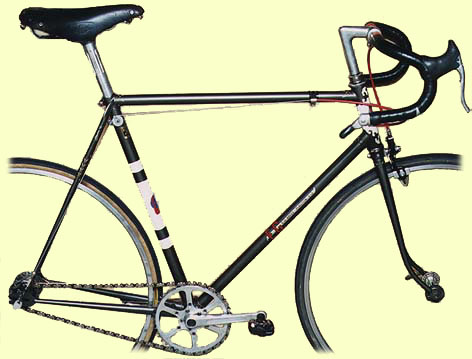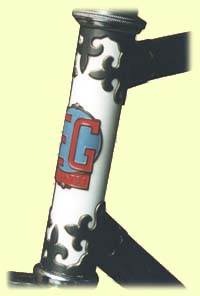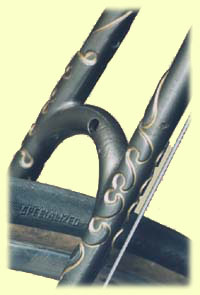
|
Tweet
Follow @sheldonbrowncom |


At the Larz Anderson Museum Show, in August, 1998, I was beguiled by a strange and elegant British frame, an E.G. Bates. It has wildly decadent, baroquely ornate lugs, somewhat reminiscent of Hetchins, and is truly a thing of beauty.
I don't know a great deal about Bates. In fact, I only just learned that there are two different "Bates" builders! Dale Brown of Classic Bike "Rendezvous" kindly explained that:
"There is Horace "Bates," Westcliff-on-Sea, Essex, with the dual bend Diadrant forks, center bulged Cantiflex tubes, etc. and
"EG Cycles" which was E.G. Bates, 591 Barking Road, Plaistow. Both were in prime form in 1950's."
The better-known (Horace) Bates is mainly known for an oddball "Cantiflex" tube set that was used on many of its bikes. These tubes were bulged oversize in the middle, but have standard size ends. I believe this was mainly a marketing gimmick, but the bikes were very well made and are highly regarded. My E.G. Bates, however, has a standard Reynolds 531 butted tubeset (except for the track fork blades.)
![]()
![]()
At first glance, it appeared to be a track frame: The rear fork ends opened to the rear, as with a track bike, and the front fork had round, not oval blades, which is also characteristic of track bikes...but it also had eyelets for fenders (excuse me, "mudguards") and was drilled for brakes. On closer examination, the tire clearances were much more generous than they would be on a track bike. I concluded that it was a fixed-gear road frame. It was close to my size, so I snapped it up.
On further examination, I'm more inclined to think that it was a club bike, probably made for use with a Sturmey-Archer hub, or perhaps with a flip-flop hub.
After mulling over various options, I decided to retire my Lenton Grand Prix, and transfer it's better parts, including the Sturmey-Archer ASC 3-speed fixed-gear hub, to the Bates. I'm using a Sun Tour Barcon to shift the hub, since I don't have the special ASC trigger, and don't much like triggers on drop bars anyway. Purists will no doubt be aghast at the Dia Compe brake caliper and Shimano brake lever, but when I only have one brake, I want it to be a good one. I'm sure it would be more authentic if I put Lyotard #23 platform pedals on it, but I've fallen completely under the spell of SPDs...
 |
 |
![]()
![]()
My father, W.A.Smee was a member from the 1930's of an East Ham, London cycling club named Roamer C.C., in which he rose to the position of Vice-President. A fellow V.P. in the fifties, and later President, was E.G. "Eddie" Bates, who owned a large cycle shop in Plaistow, which specialized in hand made racing machines. Eddie's son Alan was a very prominent racer for Roamer, winning the "All Rounder" competition for the seasons best time/distance for 50 miles/100 miles/ 12 hours. in 1961 I believe. Other famous names doing guest races in the club's colours included the World champion, Beryl Burton.
Firstly, the frame. E.G.Bates offered several different types, but their top frame was always made from Reynolds 531 tubing with the hand cut "Fleur De Lys" lugs as they were known. This is the type that you have. In the late fifties and early sixties, they were the considered to be the very best you could get, far superior to a Hetchins !!!! Being hand built, it was very much like having a suit made, with all angles and measurements tailored to the owners personal details and the type of racing it would be used for. (steeper front angle for track sprinting etc. etc.)
From the angles, yours look like a classic road/track bike, meant for short distance (25 miles) time trials and pursuit events on the track. ( Even though it has clearance for mudguards, this would still have been a proper racer. People normally rode their bike to the event and then stripped off the unnecessary bits.) At that time, it was popular to use a fixed wheel for time trialing which is what yours would have had. It would MOST DEFINITELY NOT have been fitted with the Sturmey Archer gear hub, which by the late fifties were only found on the most pedestrian of tourers and shopping bikes! Your E.G. was a genuine race machine. [but it might be early '50s, in which case the Sturmey-Archer hub is not unthinkable. --SCB] It would have been fitted with a front brake only. ( For mine, I specified a Weinmann side- pull brake. The lever was fitted "upside down" on the end of the bars.)
You were asking about the type of equipment originally fitted. Obviously this varied, but I can just about remember most of what I used. (It is a very long time ago ) As I have said, my frame was an identical E.G.Bates with track ends but with only the front fork crown drilled for a single brake. For road time trials I used Ambrosia alloy bars and extension. The chainwheel and crank was Chater-Lea. (At the time more expensive than Campagnolo but with a great tradition for track work.) Wheels were Weinmann rims with Campag L/flange hubs. Saddle was Brookes B17 Sprinter.
I went to live in California in the mid sixties in my late teens and my cycle racing with Roamer C.C. had already ended by that time.
Your web site pictures certainly brought back a lot of memories. They always were the most beautiful bikes.
I hope the above has been of some assistance.
All best regards,
David J. Smee
![]()
![]()
Last Updated: by Harriet Fell